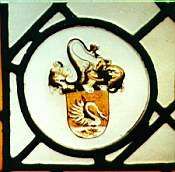Op den Graeff family

Op den Graeff, also Updegraff, Updegrave, Updegrove, Uptegrove, was a Germano-Dutch and American family.
History
The earlist Op den Graeffs lived in Aldekerk (Kleve), near the border to the Netherlands. An old family history said that the family sprang out from the Von Graben.[1] This was first published in the work Germania topo-chrono-stemmatographica sacra et profana (or Genealogica Germaniae Notitia). These are works of Gabriel Bucelin (or Buccelini, Bincelint), which were published in 1652/62. During the 17th century the Op den Graeffs were a family of linen weavers in Krefeld and continued this occupation later in Germantown, although the family purchased jointly 2,000 acres of land in Germantown. In Krefeld the family belong to the Mennonite circle, which turned Quaker in part ca. 1679-1680. In the end of the 17th century some of the Op den Graeff`s descendents migrated to the United States. They are among the thirteen families (Original 13) often referred to as the Germantown, Philadelphia, Pennsylvania Founders, who arrived on the ship Concord on October 6, 1683.[2][3][4] One of these was famous Abraham op den Graeff, a cousin of William Penn, who signed along with three others the first organized religious petition against slavery in the colonies, the 1688 Germantown Quaker Petition Against Slavery.
Abraham op den Graeffs descendants named Opdegraf(f), Updegraf(f), Uptagraff(t), Updegrave, Updegrove, Updegraph and Upthegrove. Pennsylvania Governor Samuel Whitaker Pennypacker was the fourth great-grandson of Abraham.[5] Some of their descendants continued in or returned to the Mennonite faith and were found in the Montgomery County congregations of Skippack and Boyertown until modern times.
During the earlier 19th century David Benjamin Updegraff of the Updegraff branch of the family was a conductor (one of the leaders) of the Underground Railroad. He was one of the first outspoken anti-slavery men, and voted with the first liberty party from conscientious convictions. His house was the home of antislavery advocates and temperance lecturers also a station on the Underground Railroad.
Another alleged part of the family settled in the area of Bad Kreuznach, Rhineland-Palatinate, Germany.[6] The family still live until now.
Notable family members
- Groff family, alleged branch of the Op den Graeffs
- Herman op den Graeff (1585–1642), Mennonite community leader and bishop from Krefeld
- Abraham op den Graeff (1649–1731), one of the "Original 13", politician, signer of the first organized religious protest against slavery
- Johannes de Graeff (1729–1813), Dutch Governor of Sint Eustatius, Saba and Sint Maarten in the Netherlands Antilles during the difficult time of the American Revolutionary War[7]
- Nathan Updegraff (1750–1827), a founder and delegate to Ohio's first constitutional convention
- David Benjamin Updegraff (1789–1864), conductor of the Underground Railroad, minister of Friends church
- Jonathan T. Updegraff (1822–1882), U.S. Representative from Ohio
- David Brainard Updegraff (1830–1894), minister of Friends church (Quaker minister)
- Thomas Updegraff (1834–1910), attorney and five-term Republican member of the U.S. House of Representatives from northeastern Iowa
- Ed Updegraff (born 1922), American amateur golfer and urologist
- Mark K. Updegrove (born 1961), American author and historian, director of the Lyndon Baines Johnson Library and Museum
- Stephen Updegraff (born 1962), American refractive surgeon
- Dave Upthegrove, American politician
- Dewitt Upthegrove, American businessman and politician
- Laura Upthegrove, American bandit known as "The Queen of the Everglades"
- William Hendry Upthegrove American army captain
see also:
Connection with William Penn
The Op den Graeff family was related to William Penn, the founder and gouverneur of Pennsylvania.[8][9]
lineage:
- Driessen Pletjes (1550–1645) ≈ Alet Goebels
- Alet Pletjes (1583-?) ≈ (Sir ?) John Jasper
- Margaret Jasper (c 1624-1682), 1st ≈ Nicasius Van der Schure; 2nd ≈ admiral Sir William Penn (1621–1670)
- gouverneur William Penn (1644–1718)
- Ann Jasper (born c 1628) ≈ William Crispin (1627–1681)
- Margaret Jasper (c 1624-1682), 1st ≈ Nicasius Van der Schure; 2nd ≈ admiral Sir William Penn (1621–1670)
- Greitgen Pletjes (1588–1643) ≈ mennonite bishop Herman op den Graeff (1585–1642)
- Abraham Hermans op den Graeff (~1610–1656) ≈ Eva von der Leyen
- Isaac Hermans op den Graeff (1616–1679) ≈ Grietjen Peters (died 1679)
- Abraham op den Graeff (1649–1731) -- Updegraff family
- Adolphus op den Graeff (1653–1680) -- Updegrove family
- Alet Pletjes (1583-?) ≈ (Sir ?) John Jasper
References
- ↑ Familytree
- ↑ "The Friend, Volume 48", The Friend., 1875. Harvard University. p. 67
- ↑ "Ship Passengers Mentioned in Merion MM Minutes; Chester County, PA.", Yvonne Prough. U.S. Genealogical Web Archives. Accessed 29 sept 2011
- ↑ "1683 Concord", Pro Genealogists. Accessed 29 sept 2011
- ↑ "Colonial and Revolutionary Families of Pennsylvania", John W. Jordan. Genealogical Publishing Com, 1978. ISBN 0-8063-0811-7, 9780806308111. p. 486
- ↑ Coat of arms family Graeff or Gräff Bad Kreuznach, source: Deutsche Wappenrolle, band XIII, page 15, registered at Hüffelsheim, Kreis Kreuznach, 1690
- ↑ Newspaper article (Johannes de Graeff / Op den Graeff coonection
- ↑ "History of the Op Den Graeff/Updegraff family", June Shaull Lutz, 1988, S. 1
- ↑ Mennonite World Review - More than our family tree
External links
- Op den Graeff Krefeld Stained-Glass Windows
- Google Bücher: Germania Topo-Chrono-Stemmato-Graphica Sacra Et Profana, von Gacriel Bucelin, Ulm 1655
Further reading
- Bender, Harold S. (1957) Graeff, op den (Opdegraf, Updegrave, Updegrove) family. Global Anabaptist Mennonite Encyclopedia Online. Global Anabaptist Mennonite Encyclopedia Online
- Ulle, R.F. (1983) The Original Germantown Families. Mennonite Family History April.